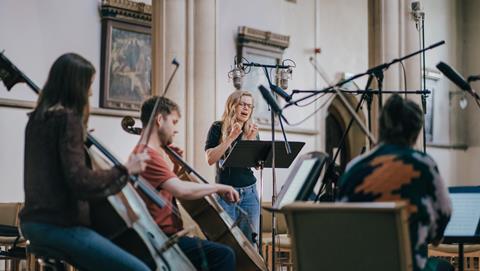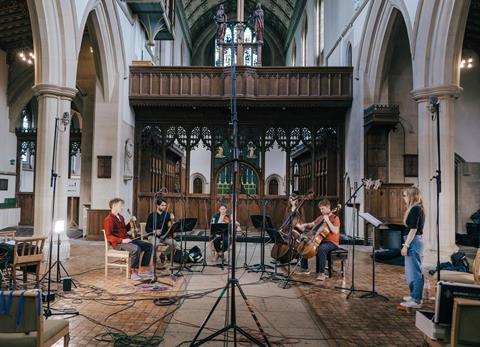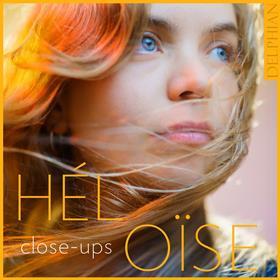The soprano and composer outlines her compositional approaches to works for voice and stringed instruments on her upcoming album, close-ups

Discover more Featured Stories like this in The Strad Playing Hub
I began my musical life as a cellist when I started to learn at the age of four. It has always been a timbre that is close to my heart and, since becoming a singer, I have always loved to perform with string instruments. Having written many works for solo voice since I first explored composition as a teenager, I have more recently been inspired to write a number of works for voice and strings and these became the starting point for the repertoire on my new album, close-ups. I wanted to record these new pieces in a big, resonant acoustic and with a dream team of string players - which I did! I feel incredibly lucky to have assembled such a stellar group of musicians: Max Baillie (violin, viola, Hardanger fiddle), Julian Azkoul (violin), Ruth Gibson (viola), Colin Alexander (cello), Marianne Schofield (double bass) and Kit Downes (cello). I rate each of them so highly, both as musicians and as people.
When I compose, I don’t have one set way of doing it - the process very much depends on what I’m writing and who I’m writing for. The four pieces of mine on the album all feature string instruments but the compositional approach for each of them was specific to its context and subject matter.
In ’close-ups’ the title track of the album, the voice and violin very much work as one entity. I tried to mix and match the two soundworlds as closely as possible. The idea behind this was aiming to create different types of personas, with the violin and voice always embodying one single character at a time. I have always loved people-watching - on the train, in shops, at the theatre; to observe people’s mannerisms and the way they use their bodies and voices. In this duo, I wanted to make some of those characters come alive. But not through words, purely through sounds. The starting point for the musical material was my voice: I came up with vocal motives that I then tried to translate on the violin in a way that would make sense on the instrument. The writing in both the vocal and violin parts is set but with elements of freedom in terms of the order in which certain motives can happen. It is a very theatrical piece which verges on comedy and, for it to work, there has to be a vibrant chemistry between the singer and the violinist.

Also theatrical in intent is my work ’Les Leçons du Mardi’ which was a collaboration with my brilliant sister Emma Werner. It is scored for soprano and string quartet and explores themes of sexism in medical history, centring around the now obsolete concept of ‘female hysteria’. From the very beginning of the writing process, I knew that I wanted the string players to not only be instrumentalists but also function as actors in the drama of the piece by harnessing the fact that string players can play and speak at the same time. The starting point for writing this work was the libretto, put together by Emma. Bridging music and science, the concept is a creative take on the infamously voyeuristic ’Tuesday Lectures’, once held at the Salpêtrière Hospital in 19th century Paris. Led by neurologist Jean-Martin Charcot, the lectures saw ‘hysterical’ women, institutionalised at the Salpêtrière, forced to act out their symptoms before an eager Parisian public.
This work reinvents the lectures in a new setting: this time it is the woman performer who holds the agency and controls the presentation. She makes the string quartet players recite quotes taken from outdated scientific texts on female hysteria as well as 21st-century everyday sources such as the urban dictionary. When not reading out these outrageous quotes, they play fast, mechanical and stubborn material which, in my mind, emphasises the insanity and absurdity of the quotes and what they represent. Gradually though, their words and sounds fade into nothingness while she delivers an imagined testimony from a female patient at the Salpêtrière. As the noise and busyness of the merged strings and voices disappears entirely to leave just one voice alone, the ridiculousness of the subject matter turns to something much more bleak and powerful.
A different compositional approach now: my piece ’Unspecified Intentions’, originally written for solo voice but which Colin and I arranged for voice and string quintet especially for this album. The way the arrangement works is that the quintet very much responds to what I do vocally and have to react as quickly as possible, like a musical game. For each motif that I sing, they have a specific motif to play in response and it’s on them to catch me as fast as possible. It’s so fun and surprising, both for me (I never know in advance which motif I’ll choose next) and for them (they definitely don’t know either!)
’Lullaby for a sister’ for voice and cello is in a way the simplest and perhaps most conventional in its compositional approach. Setting words by Emma, it uses the cello as an accompanying instrument to the voice, shadowing and echoing it, providing high and haunting countermelodies as well as short interludes made up of sonorous, melancholic double stops. I wanted to write a song that was pure and beautiful, and hopefully moving. It is about a place where we used to go on holidays together when we were little, in the south of France. Our friend Jean-Pierre, who owned the house, was very sick over the last year and so we decided to write a song for him.
Watch ‘Lullaby for a sister’ here:
Lastly, I’d like to mention the improvisations featured on the album - you could call them collaborative compositions. These were not notated on the page but devised in the recording sessions. They are the three tracks on the album called Echo I, II and III and, as their names suggest, they each reflect elements from other tracks on the album. We set aside a whole morning to record a bunch of improvisations, trying out different concepts and starting points for each them whilst exploring unusual timbres and techniques in the extremely resonant acoustic of the recording venue. Max plays Hardanger fiddle on them, echoing some of the early music tracks on the album. With such amazing improvisers in the room (Max, Marianne, Colin and Kit), I knew that whatever would come out of this session would be magical - and indeed, I couldn’t be happier with the results!

It’s been such a joy putting this album together and, whilst I imagined that there would be an exciting range of colours from the instrumental parts, the string players brought about such a nuanced variety of expressive approaches that have totally exceeded my expectations. And now, I cannot wait to perform the whole album live with these wonderful players at Southbank Centre on release day - 28 June.
Héloïse Werner and fellow musicians will appear at the album launch of close-ups at 8pm, Friday 28 June at the Purcell Room at Queen Elizabeth Hall, Southbank Centre. Find out more here.
Photos courtesy Will Coates-Gibson / foxbrush
Read: Cellist Colin Alexander: how I notate improvisations
Read: Top 5 reasons why more string players should compose: Jessica Meyer
Read more Featured Stories like this in The Strad Playing Hub
The number one source for playing and teaching books, guides, CDs, calendars and back issues of the magazine.
In The Best of Technique you’ll discover the top playing tips of the world’s leading string players and teachers. It’s packed full of exercises for students, plus examples from the standard repertoire to show you how to integrate the technique into your playing.
The Strad’s Masterclass series brings together the finest string players with some of the greatest string works ever written. Always one of our most popular sections, Masterclass has been an invaluable aid to aspiring soloists, chamber musicians and string teachers since the 1990s.
American collector David L. Fulton amassed one of the 20th century’s finest collections of stringed instruments. This year’s calendar pays tribute to some of these priceless treasures, including Yehudi Menuhin’s celebrated ‘Lord Wilton’ Guarneri, the Carlo Bergonzi once played by Fritz Kreisler, and four instruments by Antonio Stradivari.





































No comments yet